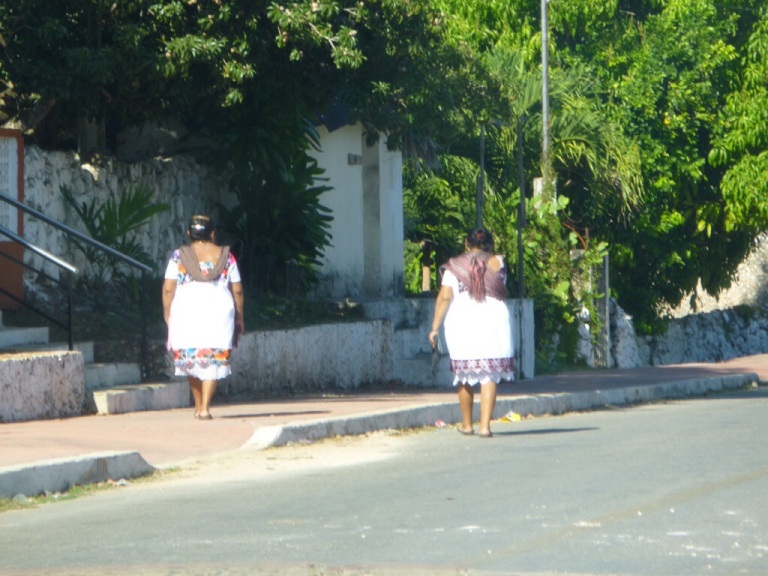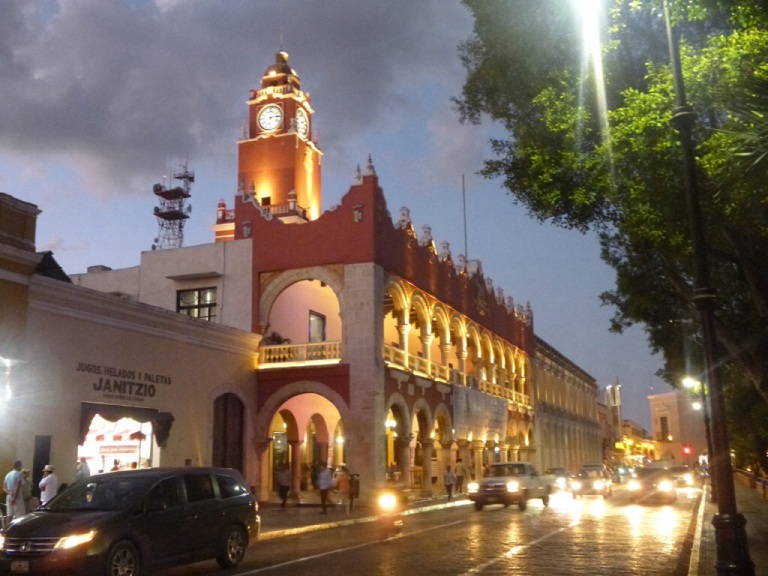Three cultures co-exist in the Yucatan Peninsula:: the Mayan culture which practices and preserves the beliefs of the Ancient Maya from medicines to meteorology; the Mestizos culture which is the mix of the native Mayans and the Spanish conquistadores (seen from the remaining haciendas and colonial towns such as Izamal and Uayma); and the Mexico today which has adopted many influences from its neighbor in the North in terms of values and lifestyles.
Mayan Heritage
As we leave the Cancun area, I am getting closer to the real taste of Mexico where one can observe the remaining few locals still adopting the traditional Maya living (from the Mayan houses, Mayan healer (curandero/curandera), and traditional clothing such as huipiles – mostly adorned by older women in the pueblitos (small towns).
I visited a Curandero in Santa Elena Sr. Don Hernan. I did not manage to get myself a medical assessment from him, but he showed me the true Mayan way of living. He showed me how hennequen fibre was obtained from the leaf and how the dried fibre can be made into a rope for a pair of sandals. He also showed me the famous achiote plant used in the famous Yucatan dishes: cochinita (pork) and pollo (chicken) pibil. To make a pibil, achiote is mixed with sour oranges. He also showed the Mayan gods that are revered to by the Mayans. One creature called aluces / enano, a small spirit creature which is often misperceived by the people to be a molester while they work on the land/on the mountain (for example by making people lose their direction/orientation). Don Hernan does not believe that is the case. He believes that one just has to pray and throw some soil to his back without turning around and he will find his way back quickly.
It is amazing how in such modern age, there are still those who believes in the ancient superstitions and way of living. Don Hernan also grows many plants in his garden, and they have medicinal properties, such as the chaya leaves and a fruit which can cure asthma. His lovely wife taught me how to make corn tortillas. It was hard! He also showed us how a Maya house was built. The construction started with the four wooden poles and a rope was used to measure distance from the middle of pole to the point where the oval wall would have been built. For his efforts, Don Hernan has been visited by many foreigners and received an acknowledgement/appreciation by the Smithsonian Institute for guarding the Mayan heritage.
Mestizos Culture
The haciendas all over Mexico and the quaint colonial towns, such as Izamal and Uayma, are witness of the birth of Mestizos culture after the arrival of the Spanish Conquistadores in Mexico in the 1490s. The term “mestizos/mestizas” refer to the offsprings of the inter-marriage of the Spanish and the local indigenous population (whether it is Maya in the context of Yucatab Peninsula). As the conquest spread and was sustained, local Mestizos and non-royal Mayans were given the governing posts, as they were loyal to the Spanish regime.
Although I find Izamal a very quaint colonial town and the best town I had seen on my trip, with its colonial yellow color buildings and immense church and monastery, I find myself not too enamored with what it represents. Izamal and Uayma were built on the destructions of Mayan buildings. The stones were removed from the Mayan cities to build the church and the main squares. The Catholics came and imposed their religion on the Mayans. As a matter of fact, the Izamal location was picked by the Spaniards because it was a Mayan city. Nine ruins are located in and around Izamal. For the Spaniards then, it was killing two birds with one stone: destroy the Mayans culture and impose theirs by stealing the stones from Mayan buildings to build their churches. The biggest irony is that 600 years later, some Spaniards I know do not even give a damn about Catholicism and about going to Church in general.
Regardless of my feelings on this subject, Uayma’s church is quite unique and worth seeing. I had never seen a colonial church decorated as such.
Another colonial town worth mentioning is Mani. This is the site where Bishop Landa burnt thousands of Maya scrolls and idols, thus much knowledge about the Mayans were gone. After that, there were two versions of the stories: 1. Apparently he regretted it so he started to document details about the mayas, or 2. His authority ordered him as a punishment to record details of the Mayan customs and that is how we know what we know about the Mayans.
Haciendas are even worse in my view. I barely visited any and honestly, nor was I too interested in them. They also represent the oppresion and exploitation by the Mestizos and the Spaniards of the Mayans as forced labors. One exhibit in the Mundo Maya museum in Merida states that the laborers were paid in coupons which could only be spent in the shop of the Hacienda owners, which meant the laborers would be unable to save money to break free of the exploitation cycle and make a better lives or themselves.
Modern, Young Mexico
The present Yucatan peninsula, is one of the most developed in Latin and South America. It has a functioning economy. It has created a larger number of middle class. In Merida, one can see more people owning cars and homes. New colonies (neighborhoods/suburbs) have emerged, enlargening the size of Merida. American restaurants (IHOP, TGIF, Starbucks, etc) and shopping chains (Walmart, Sam’s Club, Home Depot) are prevalent. Sushi places are getting to be more common. No one lives in the city centre anymore, except foreigners snapping up colonial buildings to be made into Bed and Breakfasts.
Despite the adoption of lifestyle from its neighbor in the North, the mexicans in general still have a strong family values and traditions, similar to those of Asians. The children leave home only when they marry. Families get together often for meals. I find the Yucatecans very friendly, helpful, and respectful. They are quick to warm up to people (Guatemalans I find are more distant in the beginning), but at the same time they respect your space.
Valentine’s Day is also very important for them. The women expect flowers/dinners/gifts on this day. On this day, I did see many flower sellers on the road. And the restaurant in my hotel, Meson de Marques in Valladolid, were full of local couples celebrating Valentine’s Day. I was told this restaurant charges tourist prices. It was not great though, but it was the to-go romantic spot for the couples.
The best part if the culture though is their music and dances and literature. I went to the Trova (folk music) night in Plaza Santa Lucia in Merida. The trova performance is on every Thursday night. The theme of the performance this week was of course “Love” for the Valentine’s Day. I loved the trova music by Trova Trio and the regional dance of “Jarana” which is of “Mestizaje” (fusion of Mayan and Soanish culture) origin. The best part for me was the recital of Yucatan’s poet, Ricardo Lopez Mendez’s poem “En Tu Cuerpo”.
No one can learn about the culture of others in a space of 7 days. I feel that I have barely scratched the surface, and yet I have gotten a taste of the different aspects of the Yucatan Peninsula. I am definitely coming back here – soon! ¡Ya me pique!




















